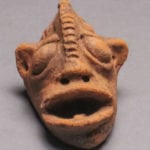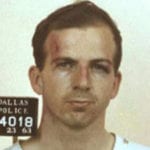 Weird Stuff
Weird Stuff  Weird Stuff
Weird Stuff  Humans
Humans The Ten Most Lethal Gunslingers of the Old West
 Misconceptions
Misconceptions 10 Phony Myths and Urban Legends That Just Won’t Die
 History
History 10 Amazing Roman Epitaphs
 Weird Stuff
Weird Stuff 10 Niche Subcultures That Are More Popular Than You Might Think
 Mysteries
Mysteries 10 Tragic Disappearances and Deaths in Joshua Tree National Park
 History
History 10 Ways Childhood Really Sucked in the Old West
 Music
Music 10 Name Origins of Famous Bands from the 1990s
 Religion
Religion 10 Biggest Turnarounds by the Catholic Church
 Weird Stuff
Weird Stuff 10 Unbelievable Times Laws Had Unintended Consequences
 Weird Stuff
Weird Stuff 10 Cool and Creepy Facts about Collecting Tears
 Humans
Humans The Ten Most Lethal Gunslingers of the Old West
 Misconceptions
Misconceptions 10 Phony Myths and Urban Legends That Just Won’t Die
Who's Behind Listverse?

Jamie Frater
Head Editor
Jamie founded Listverse due to an insatiable desire to share fascinating, obscure, and bizarre facts. He has been a guest speaker on numerous national radio and television stations and is a five time published author.
More About Us History
History 10 Amazing Roman Epitaphs
 Weird Stuff
Weird Stuff 10 Niche Subcultures That Are More Popular Than You Might Think
 Mysteries
Mysteries 10 Tragic Disappearances and Deaths in Joshua Tree National Park
 History
History 10 Ways Childhood Really Sucked in the Old West
 Music
Music 10 Name Origins of Famous Bands from the 1990s
 Religion
Religion 10 Biggest Turnarounds by the Catholic Church
 Weird Stuff
Weird Stuff 10 Unbelievable Times Laws Had Unintended Consequences
10 Pieces Of Music To Make Your Ears Bleed
Classical music is often thought of as refined, relaxing—and, well, classy. But there’s a dark side to classical, a whole vein of music that’s nearly impossible to bear. Listen to these 10 examples—if you dare.
10‘Threnody For The Victims Of Hiroshima’
Krzysztof Penderecki
You may not have heard of Krzysztof Penderecki, but you’re probably familiar with his work. Have you seen The Shining? The Exorcist? Shutter Island? Penderecki’s music was used in all of those movies.
Krzysztof Penderecki was born in a small town in Poland in 1933. The country was invaded by Nazi Germany in 1939, and Penderecki saw his town’s large Jewish population suffering as they were sent off to concentration camps. He even watched German authorities hang resistance fighters right outside his house. Is it any wonder that his music has a wild, horrifying edge to it?
Penderecki studied at the Krakow Superior School of Music, and in 1959 he won the Polish Composers Association Award three times. The next year, he composed his “Threnody for the Victims of Hiroshima.” While the work is dedicated to those who died in the Hiroshima bombing, Penderecki was influenced by his own experiences in Nazi-occupied Poland, saying that they had been in his “subconscious mind since the war.”
Emotionally and intellectually, the piece is compelling. It’s written for 52 violins played with so many unconventional techniques that Penderecki had to invent his own notation system. Sometimes, the violinists use the bow in unusual places; sometimes they hit their instruments with their fingers to make a percussive sound. Occasionally, Penderecki specifies the general shape of the phrase but not the specific notes. One of the most unusual features is that the piece is not broken into sections by beats or measures as is typical but rather by the minutes and seconds of a clock.
Nevertheless, it’s hard to listen to. It’s not exactly aesthetically pleasing. In fact, it sounds like nails on a chalkboard. No wonder horror films love using Penderecki’s music.
9‘HPSCHD’
John Cage
The well-known experimental composer John Cage has been covered several times on this site already, most notably for his famous 4’33”, a piano composition (also arranged for orchestra) consisting of perfect silence for four minutes and 33 seconds. Cage also has several compositions for “prepared piano,” so called because the instrument’s whimsical sonic effects come from prior adjustments like foil on the hammers and screws on the strings.
“HPSCHD” is something else entirely. The name “HPSCHD” comes from, and is pronounced like, the harpsichord, that twangy precursor to the piano. John Cage once said, “I’ve always hated the harpsichord. It reminds me of a sewing machine.” Odd then that wrote a piece for up to seven of the instruments—but he did do his best to thoroughly disguise the sound. The seven harpsichords are accompanied by up to 51 electronic computer-generated tracks.
The piece was a collaboration with fellow composer Lejaren Hiller and was constructed by a process that some might not even call composing. Cage and Hiller used a random number generator and other computer programs to decide on all aspects, including pitch, note length, and sound quality.
The piece’s premiere was intense. It was performed at the University of Illinois on May 16, 1969 for an audience of nearly 7,000 and required 8,000 slides and 40 film projections. It also used huge plastic screens—the aforementioned seven harpsichords—black lights and other lighting equipment—and 14 performers playing 51 audio tapes on tape decks, speakers, and other amplification equipment.
It must have been an impressive event. But none of that makes the piece any easier to listen to.
8‘Philomel’
Milton Babbitt
“Philomel” is based on a story in The Metamorphases by the Roman poet Ovid. The King of Thrace rapes Philomel then cuts out her tongue to silence her and throws her in prison. She manages to communicate what happened to her sister, the king’s wife, who kills her young son, cooks him, and serves him to the king. As he dines, she tells him what exactly he’s eating. The sister then frees Philomel, and the two run through the forest to escape the angry king. The gods get wind of what’s happening and turn all three into birds; Philomel becomes a nightingale.
Cheery tale, huh?
Milton Babbitt’s musical setting is appropriately eerie. It focuses on the moment of Philomel’s transformation into a nightingale and her recovery of her voice. (“What is that sound? A voice found?” she sings.)
“Philomel” is written for soprano, recorded soprano, and synthesizer, and the music is so bizarre, you probably need perfect pitch to sing it. It was composed using the twelve-tone system, in which all twelve notes in an octave are fitted into a 12-by-12 grid and then patterns are selected using mathematical devices. It’s fun to study if you like Sudoku. It’s a lot less fun to listen to if you like your music to have, say, a tune.
7‘Ionisation’
Edgard Varese
Ever listened to the music of Frank Zappa? Well, you may have Edgard Varese to thank.
Varese was born in Paris in 1883. He originally studied to become an engineer but soon switched to music, composing several pieces in Paris and Berlin. In 1915, he moved to America, where he felt freer to use new sounds and composition techniques.
In 1931, he wrote “Ionisation,” the first piece of music exclusively for a percussion ensemble. It sounds like sirens wailing and raccoons digging though trash, but the piece’s supporters praise it, saying that it focuses “on the minutiae of musical texture, conjuring a diverse array of subtly shaded and intricately detailed soundscapes.” Frank Zappa was one of the piece’s most famous fans. Some even credit the piece with inspiring him to write music.
6‘Erwartung’
Arnold Schoenberg
Arnold Schoenberg invented twelve-tone music, which produced such monstrosities as Babbit’s “Philomel.” But that genre was downright traditional compared with some of his other material.
Schoenberg was born in Austria on September 13, 1874. (This gave him a fear of the number 13; he’d later die on July 13 in 1951.) His family was not musical and he was mostly self-taught, playing the cello and discovering an aptitude for composing. He believed that the logical progression of modern music would lead to the complete breakdown of tonality—in other words, music no longer needs melody, harmony, or any of those other pesky reasons for which most of us listen to it. He wrote music that is often called “atonal.”
“Erwartung” is one of those works. Written in 1909, it’s a half-hour drama about an unnamed woman wandering a forest, looking for her lover. Eventually he’s found dead and covered with blood, but it’s uncertain who killed him and why. It’s also uncertain why anyone would care, after 30 minutes of random musical swoops and flutterings.
5Wozzeck
Alban Berg
Alban Berg was born in Vienna in 1885 and, like Schoenberg, studied music on his own at the beginning of his life. Soon, however, he began learning from Schoenberg himself. In fact, Schoenberg and Berg, along with another composer named Anton Webern, formed the principal members of a group known as the Second Viennese School. Their music was characterized by German Romanticism and twelve-tone atonality.
Berg was drafted into the Austrian army during World War I, where he served 11 months before being discharged for poor health. The experience had a profound effect on him, and after seeing Georg Buchner’s play Woyzeck, about a cruelly brutalized private, he was inspired to set it to music. The result was his opera Wozzeck, in which a poor soldier struggles to support his girlfriend and illegitimate child, humiliated by nearly everyone he meets. Eventually, he discovers that his girlfriend has been unfaithful. He kills her then drowns trying to retrieve the murder weapon from a lake. The final scene shows their orphaned toddler, still unaware of what has happened to him.
The story is compelling. The music, maybe not so much. In the spirit of Schoenberg and the Second Viennese School, it’s atonal. Thought it was hard to listen to 30 minutes of music without a tune? Try an hour and a half.
4‘Music Of Changes’
John Cage
John Cage’s contributions to unlistenable music extend even beyond ‘HPSCHD.’
More than a few people have suggested that John Cage’s “ideas were more interesting than his music.” “Music of Changes” is a good example of that. The title of this solo piano work references the Chinese oracle book the I Ching, or “Book of Changes.” As a matter of fact, Cage used the I Ching to develop games of chance used to decide pitch, timbre, note duration, and pretty much everything else in “Music of Changes.”
The result is a fascinating score packed with highly specific and unconventional musical phrases and techniques—and sounding like an animal or small child going to town on your piano keyboard. It’s so demanding to play that it’s hardly ever performed.
3‘Black Angels’
George Crumb
Despite the composer’s whimsical name, this piece is anything but lighthearted. Finished on Friday the 13th, March 1970 and inscribed, “in tempore belli” (in times of war), “Black Angels” was inspired by “terrifying things in the air,” according to George Crumb himself.
The late 1960s was an unsettling time in the United States. Martin Luther King Jr. and Robert Kennedy had recently been assassinated, the Vietnam War was ongoing, and this ominous mood is reflected in many of the piece’s sections, such as “Devil-Music” and “Night of the Electric Insects.” The piece also samples earlier macabre works of music, such as Franz Schubert’s Death and the Maiden and the medieval melody Dies Irae (“Day of Wrath”).
“Black Angels” was written for a string quartet consisting of two violins, one viola, and one cello. This is a traditional ensemble, but Crumb pushed the instruments “to the threshold of pain.” The musicians play their instruments in many nontraditional ways, including putting thimbles on their fingers and trilling the strings. They shout, chant, and whisper. They play gongs, maracas, tam-tams, and even water-filled goblets. The overall effect may be groundbreaking, but it’s also terrifying.
2‘Gesang Der Junglinge’
Karlheinz Stockhausen
Ever thought little kids’ singing sounded creepy? Wait till you get an earful of this. “Gesang der Junglinge” means “song of the youths” and combines children’s voices with electronic sounds in a sinister way that sounds straight from the depths of hell.
Surprisingly, composer Karlheinz Stockhausen was devoutly Catholic and the piece began as a Catholic mass. However, the church decided that loudspeakers couldn’t be used in a cathedral, which was a problem for Stockhausen’s plugged-in vision.
He changed plans, and instead of a mass, he composed a non-liturgical religious work based on the “Song of the Youths in the Fiery Furnace” in the book of Daniel. It seems like good subject matter for the music’s demonic sound until you learn the boy is actually singing words like “Preiset den Herrn, ihr Engel des Herrn” (“O ye angels of the Lord, praise ye the Lord”).
The piece is especially remarkable considering it was put together in using a four-track tape recorder. Stockhausen manually cut and pasted a recording of a 12-year-old boy singing, mixing in white noise, pure tones, and other electronic noises.
The premiere of “Gesang der Junglinge,” in Cologne, Germany in 1956, caused protests and even a lawsuit against the radio network. However, Stockhausen’s influence was lasting. He was even one of the figures on the cover of the Beatles album Sgt. Pepper’s Lonely Hearts Club Band.
1‘Night Traffic’
Paul Lansky
The cliched opener for music textbooks is to ask the difference between music and noise. Paul Lansky obviously pondered the same question, and his answer is surprising.
Though he once said the sound of traffic is “music to no one’s ears,” in 1990, he sat by the side of the road with a microphone and recorded passing vehicles. Then he adjusted the sound quality using computer algorithms to create his music. He calls the result “Night Traffic.”
It’s the kind of art described using sentences like: “There is a kind of randomness, violence, and rhythmic intensity (and great Doppler shifts!) which draw upon and excite all sorts of musical perceptions.” And: “The imposition of slowly shifting harmonies and timbres creates large-scale musical shapes which attempt to impose some order and sense on this chaos, while explicating whatever implicit music there is in the movements of these large violent machines.”
+‘The Most Unwanted Song’
Dave Soldier And Komar & Melamid
“The Most Unwanted Song” is not classical music, but it’s too good—or too bad—to pass up.
In 1996, composer Dave Soldier and artists Komar & Melamid put out a survey of American musical preferences. Based on their findings, they created this, the most unwanted song, combining all the elements Americans say they don’t like. It’s 25 minutes long and has abrupt changes between fast and slow sections, loud and quiet sections, and high and low sections. It features bagpipes, organ, accordion, tuba, and other reviled instruments. At other points, an operatic soprano sings rap and atonal music, and a children’s choir sings advertising jingles and holiday songs.
According to Soldier, “It can be shown that . . . fewer than 200 individuals of the world’s total population would enjoy this piece.”
Emily Carroll is a teacher, writer, and knowledge enthusiast living in Madrid. You can follow her adventures abroad on her blog.








